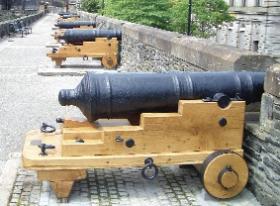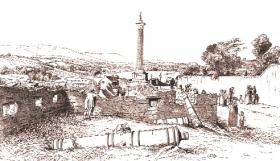Cannon in the Maiden City: symbol and document
Published in Early Modern History (1500–1700), Features, General, Issue 6 (Nov/Dec 2009), Volume 17
Fully restored cannon on appropriate block carriages on Derry city walls in 2005. (Guildhall Press)
The circuit of the ‘Maiden City’ is perhaps the best preserved of all the 52 walled towns or cities in Ireland. Although the walls have lost a number of their original features, it is nevertheless still possible to get a clear picture of the dispositions made by the planners and to understand their intentions. Preserved within that circuit is one of the best collections of provenanced and documented late sixteenth- and seventeenth-century cast-iron ordnance anywhere in Europe.
Conservation and restoration project
In 2005 the Economic Development Section of Derry City Council identified the preservation and restoration of the cannon as a priority tourism development project, and as part of the Walled City Signature Project Action Plan they commissioned a full conservation and restoration project. Despite the unsightly nature of the corrosion, cast iron is a material that responds well to chemical stabilisation. Thus, after stripping off the old paint, original metal surfaces could be treated to remove active corrosion. Applications of thin but highly impermeable protective materials prepared the guns for a return to display.
Of particular interest was the recovery of a number of surface features obscured totally by layers of paint. It was known that in 1642 the London Companies had sent guns in response to pleas from the city authorities that Derry had no ordnance for defence against insurgents. Before the programme started, however, only four could be identified. It was thus exciting to recover the inscriptions on a further three guns, including that of the Worshipful Company of Grocers. In addition, removing over-paint from one demi-culverin bearing the rose-and-crown emblem revealed the initials of Thomas Johnson, royal gun founder to Elizabeth I between c. 1584 and 1595, while the cleaning of another gun exposed the initials of John Brown, whose father Thomas had succeeded Johnson.
Identification

Cannon strewn about Londonderry’s Double Bastion in 1837. (OS Memoirs of the Parish of Templemore, 1837)
Purely stylistically, it proved possible to separate out the seventeen pieces that would best be dated to the earlier part of the seventeenth century and before, but virtually all of these had associated records documenting their provenance. Two with rose-and-crown emblems are Elizabethan, while Thomas Johnson’s demi-culverin is identified with a piece ordered by the earl of Essex in 1598 for Lough Foyle, via Sir Henry Bagenal in Dublin. Bagenal’s defeat at the Yellow Ford, however, meant that they seem not to have reached Ireland until after the start of Sir Henry Docwra’s campaigns in 1600.
A further five guns bore variants of the arms of the City of London cast in the mould. They were clearly bespoke pieces, therefore, almost certainly part of a consignment of ten cast-iron cannon sent for the defence of Culmore in 1620. A copy of the royal warrant survives, naming one Roger Rose as permitted to export them, and similar accounts show that the shipment comprised two demi-culverins, four sakers, two minions and two falcons, priced at 12s per cwt, then the rate for cast-iron ordnance. The late R. J. Hunter identified Roger Rose as an English merchant in Strangford, Co. Down, who had been in London with the William and Joan, which transported the guns and other materials. Edmond Turville, a dealer who also supplied the East India Company, procured the ordnance. Indeed, the shot for the cannon was also purchased from the East India Company, and a senior officer, Richard Mountney, organised transport from the foundry and the proofing in London. John Evelyn, whose family monopolised gunpowder production for many years from the late sixteenth century, supplied the powder.
Thomas Covell, who provided muskets and gunners’ accessories, and William Felgate, who supplied powder and shot for the proofing of the guns, had close connections, while the accounts also record the names of the ship’s captain (John Betson of Coleraine) and the supplier of lead (George Petty), as well as the then commander of Culmore (Captain John Baker). They tell us the costs in 1620 of powder (£4 per barrel), lead for shot (8s 6d per cwt), cast-iron shot (between 8s and 10s per cwt) and match (£1 15s 6d per cwt).
Along with guns bearing a distinctive ‘club-and-arrow’ mark, linked firmly to the royal gun founder, John Brown, seven demi-culverins bear the names of London companies (Vintners, Salters, Fishmongers, Mercers, Grocers and two from the Merchant Taylors) and the date 1642. Londonderry in late 1641 had only four pieces of ordnance for its defence, leading to frantic appeals to the London Companies, and on 18 March 1642 the lord mayor, Sir Richard Gurney, issued a precept calling on the Companies ‘. . . that upon your consultation you will resolve of doeing something therein by providing one or more peeces of Artillory for the said Cittie of London Derry . . .’. Eleven of the twelve Great Companies (the exception being the Haberdashers) responded by sending one or two guns, fifteen in all, with carriages, ‘apurtenances’, shot and powder.
Along with the Companies’ records is the testimony of the Revd Richard Winter, who later in 1642 recorded the arrival of fifteen guns, and his description corresponds with the company accounts. Unlike the 1620 consignment, this comprised a mixed bag purchased hurriedly through Samuel Ferrers, commercial agent for John Brown, and organised by Felgate, who had risen to the rank of warden in the Skinners after a long and chequered career. Since Felgate had long-standing maritime interests, he most likely organised the shipping, in the Charity of London, from Tower wharf to Londonderry.
The surviving weapons show a mixture of stylistic traits. Were they not marked and tied definitively to a single historic event, they could be only loosely connected typologically. It is the wealth of documentation that binds them together so firmly. The role of Felgate comes into sharper focus since, unlike the other companies who paid the going rate of 13s 6d per cwt for their ordnance, the Skinners paid only 12s by purchasing from the East India Company, a connection already seen in the Culmore consignment. Records also provide the names of the carpenters and wheelwrights who worked on the gun carriages (John Pitt and Thomas Bateman), the proofer of the guns (William Franklin) and the engraver (Abraham Preston) whose elegant lettering defines each.
The role of gun founding in the Industrial Revolution
Two six-pounder guns preserved in the city and produced between c. 1773 and 1796 by John Wilkinson at Bersham, North Wales, emphasise the crucial role of the gun founder in the Industrial Revolution. Wilkinson perfected a method of boring out from a solid casting, but with the cutting head stationary while the cannon rotated and moved forward against it, to produce true cylinders. At the same time, in an entirely different industrial setting, Boulton and Watt could not obtain true-bored cylinders for their steam engine. It was the Wilkinson technology, devised to improve weapons of war, that also allowed the development of that powerhouse of the Industrial Revolution.
The guns preserved in the Maiden City can be viewed simply as lumps of metal, meant only to wreak death and destruction, symbols of past conflicts. But they are also elegant examples of the early work of founders in cast iron, who throughout the seventeenth and eighteenth centuries refined their production methods to develop an industry fundamental to the Industrial Revolution. They were products from the centre of an industrial complex of interrelated industries—mining, charcoal production, saltpetre manufacture, transport, import of sulphur, all aspects of the founder’s art and, of course, the ever-present arms trade. Finally, from the mid-sixteenth century onwards, the trend towards ever more powerful artillery trains was a key factor leading to the greatly increased cost of warfare and the development of banking mechanisms necessary to service it. HI
Brian Scott is archaeological editor for the Environment and Heritage Service of the Northern Ireland Department of the Environment.
Further reading:
B.G. Scott, R.R. Brown, A. Leacock and C.J. Salter, The great guns like thunder: the cannon from the City of Derry (Londonderry, 2008).
R.D. Smith, ‘A carriage and cast-iron cannon at Windsor Castle’, Journal of the Ordnance Society 13 (2001), 25–38.
Glossary
Demi-culverin A bore averaging 4?ins (11.4cm) and firing a shot of 9–12lb (4.1–5.4kg).
Saker A bore averaging 3?ins (8.9cm) and firing a shot of 5–6lb (2.3–2.7kg). Used both to loosen stonework and as an anti-personnel weapon.
Minion A bore averaging 3?ins (8.3cm) and firing a shot of around 4lb (1.8kg). Primarily an anti-personnel weapon for use in the field.
Falcon A bore of 2?ins (7cm) and firing a shot of 2?–3lb (1.1–1.4kg). Like the falconet below, a field piece used as an anti-personnel weapon.
Falconet A bore averaging 2?ins (5.7cm) and firing a shot of around 1?lb (0.7kg).
















